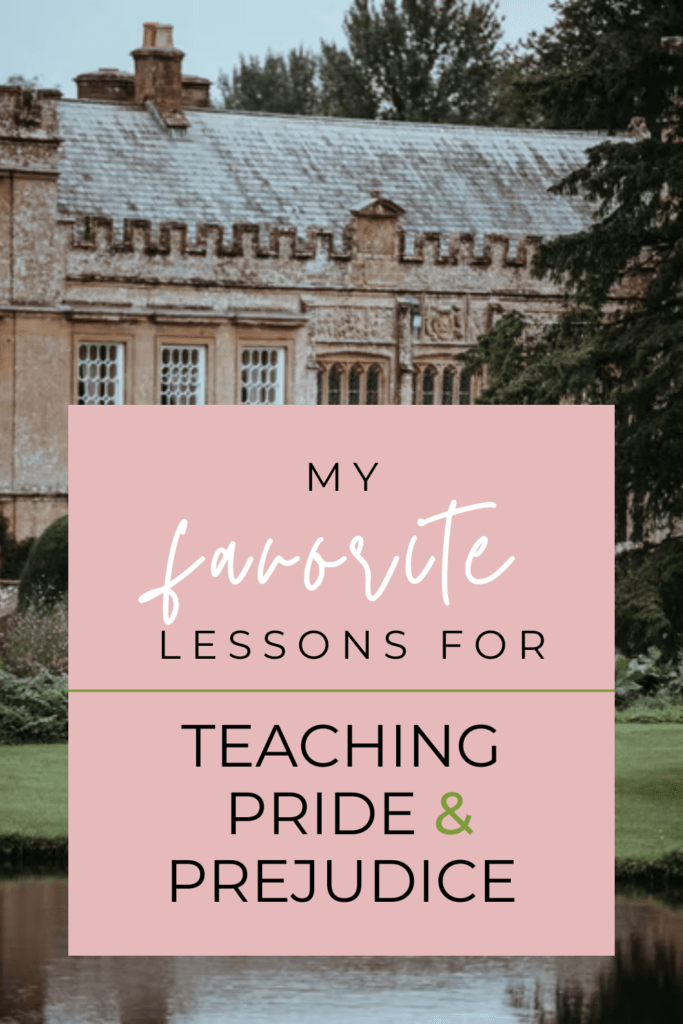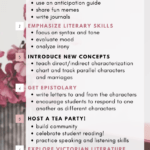On Tuesdays and Thursdays, my students begin class with silent reading time. To model a love of reading, I also read during that time. A few weeks ago, I finished my book (the campy and delightful Deep Secret) and forgot to pick up a new book from the library. When the bell rang and I realized I didn’t have a book, I went to the classroom library to choose a title.
My eyes instantly found Pride and Prejudice, and I knew it was time to revisit the Bennett sisters.
Anytime I read a book I’ve taught, it’s kind of like a game. I think about how I’ve handled this book in the past, where I ran into challenges, and what I would do differently if I were starting this unit today.
Well, after my impromptu reread of Pride and Prejudice, I wanted to share some of my favorite lessons, ideas, and inspiration for teaching this novel in class!
This post this post may contain affiliate links. Please read the Terms of Use.
Building Anticipation for Pride and Prejudice
At the beginning of a unit, I work hard to generate excitement! With novels like Pride and Prejudice, which carry a lot of connotative baggage, I work even harder to get students engaged quickly.
In particular, I love anticipation guides as a way to get students talking about a text while also previewing key conflicts and themes. Grab my free anticipation guide today!
Similarly, journaling is a great way to help students enter the world of a text. Especially in reading-heavy units, journals are a great way to make sure students are still writing consistently.
Furthermore, students retain more and process more of material about which they write. Writing can help students make connections, figure out their opinions, and develop a more nuanced understanding of a text and of themselves. Journals are also handy because they are flexible. A good journal prompt can be a bell ringer, exit ticket, or conversation starter. Check out these 28 journal prompts for Pride and Prejudice!
Literary Skills
Anytime I choose a text for class, I always have a few skills, concepts, or standards in mind. For example, “A Worn Path” is the perfect text for teaching deliberate ambiguity while “A New England Nun” is ideal for teaching deconstruction.
Similarly, Pride and Prejudice is an ideal text for reviewing irony and tone. At the beginning of the novel, students might review irony with these videos from Ted-ed. Then, as we read and annotate, we will make special note of the novel’s use of irony.
Additionally, we will also review tone with some task cards before using our irony annotations to look at places where Jane Austen uses irony and tone together. I’ve even put together this worksheet to help students review irony in Pride and Prejudice.
Introducing New Concepts
Furthermore, Pride and Prejudice is a great novel for introducing new concepts. For my students, this is the novel that helps us elevate our understanding of characterization. Up to this point, students typically understand static/dynamic and round/flat characters, but most of them have never worked with direct/indirect characterization and/or parallel characters.
To help students activate prior knowledge about characterization, we might use these characterization task cards. Then, I do a quick mini-lesson about direct and indirect characterization. To help with this, I’ve designed a quick worksheet with examples of direct and indirect characterization in Pride and Prejudice. Students then can show their mastery of characterization with one of these printables.
Once students have a firm grasp of direct and indirect characterization, I introduce parallel plots and characters. In the classroom, we will make a plot diagram anchor chart that tracks the ups and downs of the novel’s key relationships. We put each relationship in a different color and evaluate the growth of each relationship. By the time we’re finished, Elizabeth and Darcy have a more volatile line while the Gardeners have a very steady line. To help students follow all of these, you can grab this marriage chart graphic organizer.
Letter Writing
Early on in our study of Pride and Prejudice, I introduce the term “epistolary novel.” Many students have heard of the Biblical epistles, and some students have read “Letters from an American Farmer.” Still other students have read more modern takes on the epistolary novel like Diary of a Wimpy Kid, Dash and Lily’s Book of Dares, or The Martian.
Once students have an understanding of this vocabulary term, we are able to discuss why Jane Austen makes this choice. How does the frequent use of letters advance the plot, develop the characters, or affect the novel’s pacing?
In particular, I love that this writing style allows students to practice their own letter writing. For students, letter writing is a great way to practice tone. To make this even more engaging, teachers can arrange for students to “send” their letters to classmates in the same class or, if you’re really ambitious, across class sections.
Plus, my students usually get a kick out of receiving “mail” and decorating their envelopes. To make my life a little easier, I have three fully editable rubrics for grading student letters.
Tea Party
As a culmination to our study of Pride and Prejudice, it’s fun to host a classroom tea party! In pandemic times, this means pre-packaged snack cakes and Uncrustables while students drink Capri Sun with their pinkies up. To make this food day instructional, here are two fun options:
First, structure your tea party as a discussion. If you’re limiting classroom movement, this can be a Socratic Seminar where students stay in one place, sip “tea”, and evaluate the author’s choices. If you’re able to include more movement, spread the food and drinks out at stations, and students can rotate through each station World Cafe Style! The nice thing about tea party discussion is that you can host this several times throughout the novel. This doesn’t have to be a culminating activity.
Secondly, if you do want a culminating activity, your tea party is a perfect complement to a class viewing of Pride and Prejudice. While the BBC version of Pride and Prejudice holds a special place in my heart, for the sake of time, I usually show the Keira Knightley version. As students sip their tea, they can track differences between the novel and film adaptations. Not only is this a fun food day, but this is also a great way to work on synthesizing across media.
PS: If you’re short of time and can’t show a full adaptation, Crash Course does have two Pride and Prejudice episodes. You can grab my listening guides, too!
Victorian Poetry Pairings for Pride and Prejudice
Victorian culture permeates Pride and Prejudice, so I also like to help students consider some of the Victorian literature Austen might have been reading. In addition, incorporating a few poems helps students practice synthesizing and exposes them to literary devices in different contexts. Here are some of my favorite Victorian poems:
- To begin, my favorite poem is “Spring and Fall: To a Young Child” by Gerard Manley Hopkins. On the surface, this might seem like an odd text pairing, but it works for three reasons. First, the woman in the poem, Margaret, grows up during the poem in much the same way the Bennett sisters mature. Second, the seasons and weather are symbolic in both the poem and in Pride and Prejudice. Finally, Hopkins’ sprung rhythm and rhyme are a great opportunity for students to practice analyzing text structure in the same way they’ve been analyzing epistolary structure in Pride and Prejudice. Read the poem here.
- Additionally, “Dover Beach” by Matthew Arnold is the quintessential Victorian poem. Arnold’s structure, like Austen’s, lends itself to analysis. Similarly, Arnold’s speaker reminds me so strongly of Darcy! Like Pride and Prejudice, the poem’s setting is also important. Read it here.
- Finally, my students have usually read “The Charge of the Light Brigade” by Alfred, Lord Tennyson long before they arrive in my classroom. For this reason, after a quick re-read of this poem, we switch to “The Last of the Light Brigade” by Rudyard Kipling. In particular, this poem does a good job helping students understand the social struggles happening in the Victorian era. Read it here.
Literary Criticism with Pride and Prejudice
As students work through Pride and Prejudice, they can dig deeper into the text by applying some different critical lenses. One of the advantages of this text is that it lends itself to a variety of critical perspectives. If your students are new to literary criticism, this graphic organizer helps them distinguish critical perspectives and track them throughout a text.
- Firstly, Jane Austen’s life lends itself to biographical criticism, which is always an easy lens for students to grasp quickly. To help students out, I’ve put together this set of worksheets to help them learn about Austen’s life.
- Similarly, the historical contexts in which the text was written and published play a significant role in the text. For example, Wickham’s appearance, Charlotte’s decision, and Lady Catherine’s attitude are all best read in their respective contexts. Historical criticism is a favorite of mine, so I’ve already written an entire post about this critical perspective!
- In addition, teachers can also raise the stakes a little by helping students evaluate the text through feminist and Marxist lenses. Gender roles and social class both play a significant role in the text, so I use this printable to help students understand these text elements.
Modern-Day Adaptations
The sheer number of Pride and Prejudice adaptations is a testament to the story’s staying power and ability to captivate each new generation of readers! To expand on this unit or help students synthesize across decades, teachers can introduce some of these favorite adaptations. A book tasting is a great way to help students sample some of these fun titles!
- Ayesha at Last by Uzma Jalaluddin
- Death Comes to Pemberley by P.D. James
- Eligible by Curtis Sittenfeld
- Pride by Ibi Zoboi
- (on my TBR) Pride and Premeditation by Tirzah Price
- Pride, Prejudice, and Other Flavors by Sonali Dev
- Unmarriageable by Soniah Kamal
Grab my favorite resources for this novel with my Pride and Prejudice bundle!


Images from Elaine Howlin, Heather Barnes, Katherine Hanlon, Annie Spratt, Ann Fossa, Sixteen Miles Out, and Paige Cody

















